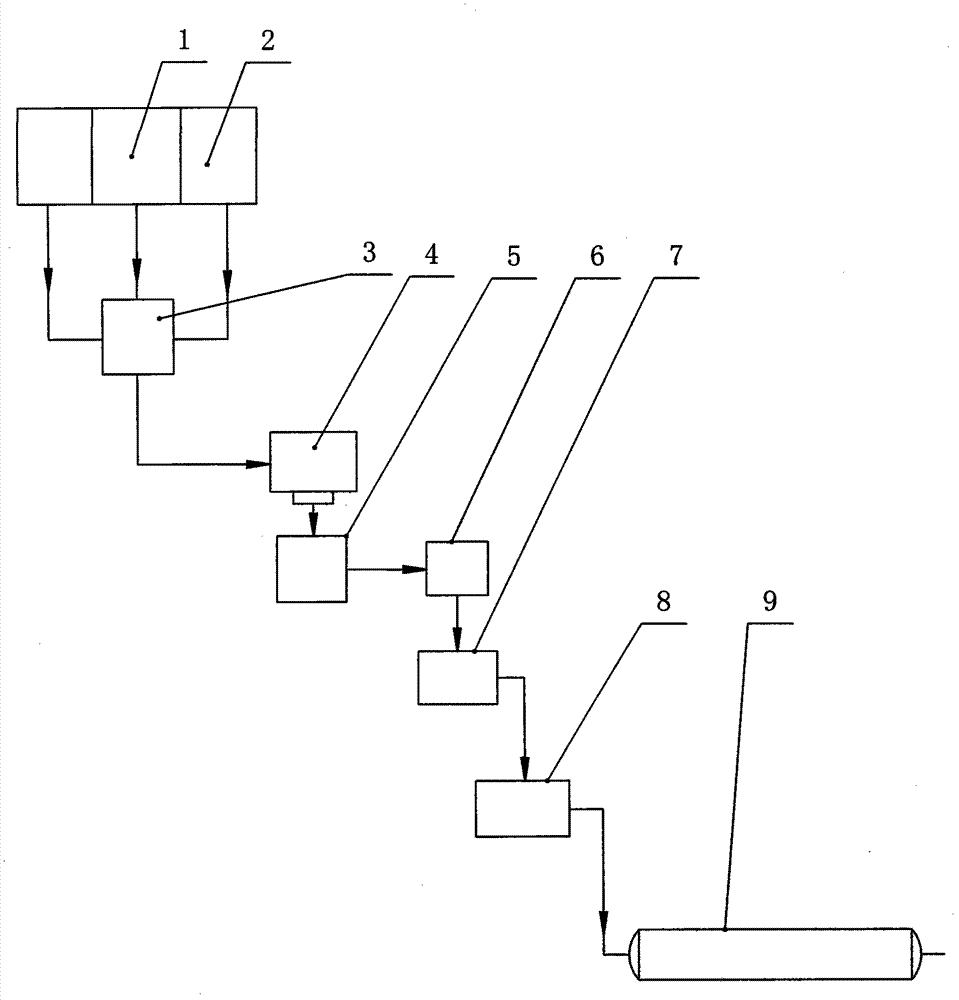Process for producing bricks by using saponification residual slag
A residue and saponification technology, applied in the direction of climate sustainability, sustainable waste treatment, solid waste management, etc., can solve the problems of secondary pollution, land occupation, etc., and achieve the goal of saving land resources, simple equipment and process, and simple production process Effect
- Summary
- Abstract
- Description
- Claims
- Application Information
AI Technical Summary
Problems solved by technology
Method used
Image
Examples
Embodiment 1
[0020] A kind of technology utilizing saponification residue to make brick, comprises the steps:
[0021] (1) Pre-treatment of raw materials: crush the aggregates, fly ash, and aggregates in the saponification residue with a dry content of calcium hydroxide greater than 30%, so that the particle size of the aggregate is 2 to 5mm, and the particle size of the saponification residue is The diameter is less than 3mm to improve the mixing degree of subsequent materials and enhance the probability of reaction; the loss on ignition of the fly ash is less than 8%, the content of silicon dioxide and aluminum oxide is greater than 70%, and the pre-treated raw materials are respectively fed into In each storage hopper 2 in the batching machine 1;
[0022] (2) Batching: the pre-treated materials stored in each storage hopper 2 are according to the percentage by weight: 20% of saponification residue, 15% of aggregate, and 65% of fly ash are batched by batching machine 1;
[0023] (3) Mat...
Embodiment 2
[0028] A kind of technology utilizing saponification residue to make brick, comprises the steps:
[0029] (1) Pre-treatment of raw materials: crush the aggregates, fly ash, and aggregates in the saponification residue with a dry content of calcium hydroxide greater than 30%, so that the particle size of the aggregate is 2 to 5mm, and the particle size of the saponification residue is The diameter is less than 3mm to improve the mixing degree of subsequent materials and enhance the probability of reaction; the loss on ignition of the fly ash is less than 8%, the content of silicon dioxide and aluminum oxide is greater than 70%, and the pre-treated raw materials are respectively fed into In each storage hopper 2 in the batching machine 1;
[0030] (2) Batching: the pre-treated materials stored in each storage hopper 2 are according to the percentage by weight: 35% saponification residue, 30% aggregate, and 35% fly ash are batched by the batching machine 1;
[0031] (3) Material...
Embodiment 3
[0036] A kind of technology utilizing saponification residue to make brick, comprises the steps:
[0037] (1) Pre-treatment of raw materials: crush the aggregates, fly ash, and aggregates in the saponification residue with a dry content of calcium hydroxide greater than 30%, so that the particle size of the aggregate is 2 to 5mm, and the particle size of the saponification residue is The diameter is less than 3mm to improve the mixing degree of subsequent materials and enhance the probability of reaction; the loss on ignition of the fly ash is less than 8%, the content of silicon dioxide and aluminum oxide is greater than 70%, and the pre-treated raw materials are respectively fed into In each storage hopper 2 in the batching machine 1;
[0038] (2) Batching: according to the percentage by weight, the pre-treated materials stored in each storage hopper 2 are: 30% saponification residue, 25% aggregate, and 45% fly ash are batched by the batching machine 1;
[0039] (3) Materia...
PUM
| Property | Measurement | Unit |
|---|---|---|
| particle diameter | aaaaa | aaaaa |
| particle diameter | aaaaa | aaaaa |
Abstract
Description
Claims
Application Information
 Login to View More
Login to View More - R&D
- Intellectual Property
- Life Sciences
- Materials
- Tech Scout
- Unparalleled Data Quality
- Higher Quality Content
- 60% Fewer Hallucinations
Browse by: Latest US Patents, China's latest patents, Technical Efficacy Thesaurus, Application Domain, Technology Topic, Popular Technical Reports.
© 2025 PatSnap. All rights reserved.Legal|Privacy policy|Modern Slavery Act Transparency Statement|Sitemap|About US| Contact US: help@patsnap.com

